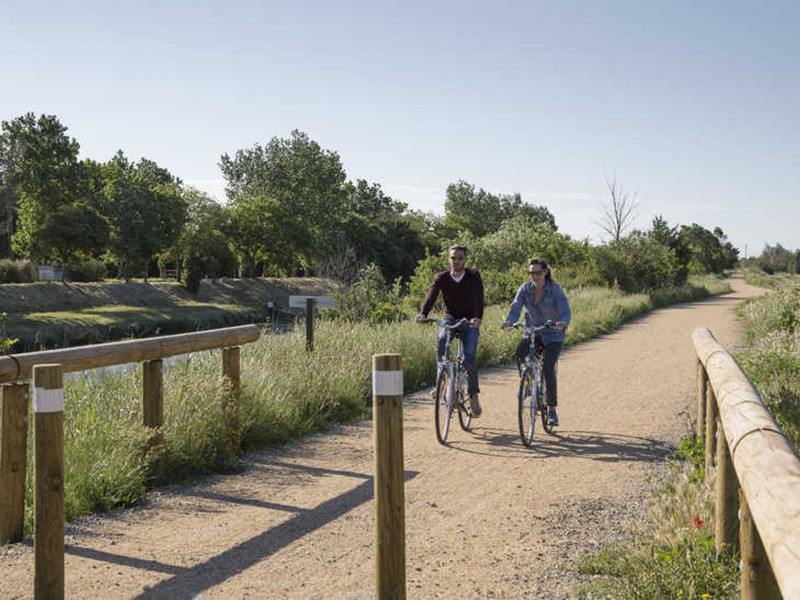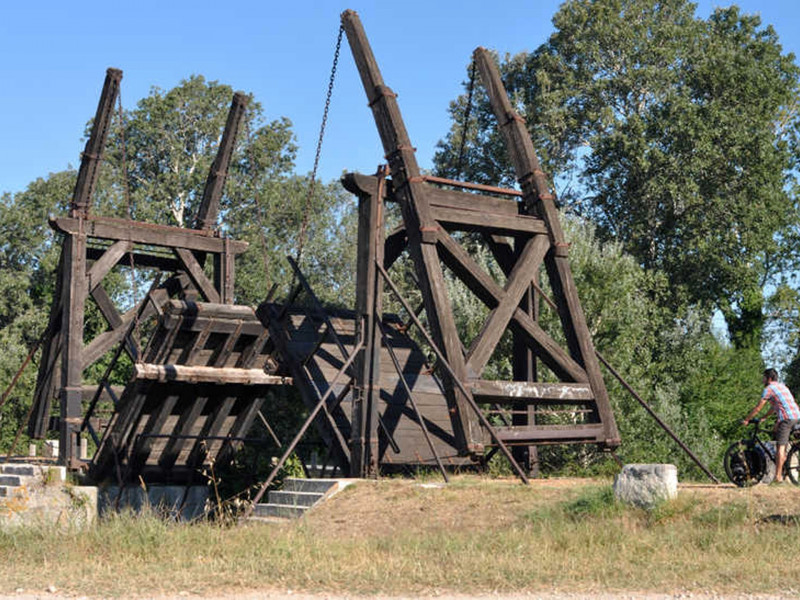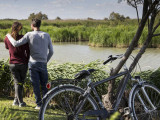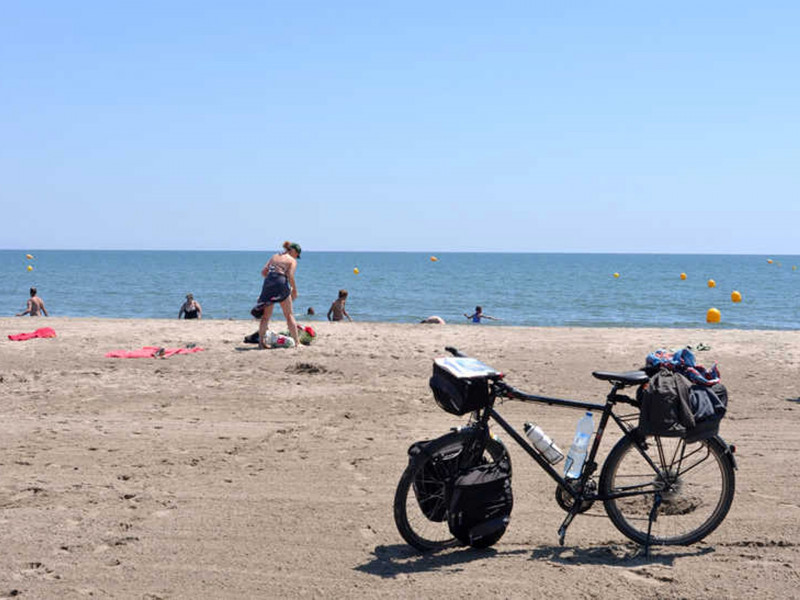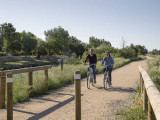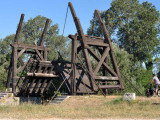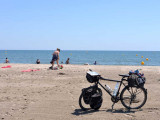On the Viarhona between Arles and Port Saint Louis du Rhône
SportPresentation
At the gates of the Camargue, Arles and its extraordinary Roman heritage invites you to immerse yourself in this city full of art and history.
From the Van Gogh bridge, the ViaRhôna itinerary takes the direction of the Rhone delta on a beautiful greenway along the canal from Arles to Fos. In Port Saint Louis du Rhône, a bicycle path will lead you to the Napoleon beach for a well-deserved swim. At Mas Thibert, don't miss an excursion to the Vigueirat marshes. Cross the Rhone and discover the territory of Salin de Giraud, the coron du Sud.
North of Arles the Via-Rhôna continues :
- towards Beaucaire-Tarascon, then continues from Avignon to Lake Geneva.
- to Saint-Gilles, Aigues-Mortes, Palavas-les-Flots to Sète.
Your itinerary starts in Arles, and more precisely at the Musée d'Arles Antique.
It is in a contemporary building, built on the remains of the Roman circus by Henri Ciriani, that the departmental museum of ancient Arles, presents the archaeological collections of Arles (everyday objects, architectural elements, mosaics, sarcophagi, models ...).The visit of this place is essential to better understand the evolution of the Roman city. On October 5, 2013 the Departmental Museum of Ancient Arles opened to the public a new wing of 800 square meters that hosts the Roman barge out of the Rhone in 2010. It is a flat-bottomed boat, 31 meters long, the best preserved in the world.
Follow the Via Rhona to the Van Gogh Bridge (2.5 km)
Named after the employee who was in charge of guarding and handling it, the "Langlois Bridge" became world famous thanks to Van Gogh's representations of it at the end of the 19th century. The bridge that can be seen a few kilometers south of the city center, on the canal from Arles to Bouc, is however not the one painted by the artist. Nor is it in its original location. Technical progress, the evolution of urban planning and the hazards of war have meant that today we can only see an identical example, formerly installed in Fos.
Here begins the Viarhona Arles - Port-Saint-Louis-du-Rhône in exclusive right-of-way. Drive quietly 16 km to the hamlet Mas Thibert.
The village of Mas-Thibert is located between the great Rhone and the canal from Arles to Bouc. Since 2011 (decree n° 2011-177 of February 15, 2011), the village is part of the Regional Natural Park of the Camargue. In the sixties, following the Algerian war, a community of harkis came to settle there. Today it is one of the largest in France.
At Mas Thibert you can leave the Viarhona to taste wine at Domaine Attilon. To do so, take the direction of Arles on the RD35 (round trip 7 km).
The Domaine de l'Attilon is located between Crau and Rhône. The exploitation of the vine on this very old property goes back to the XVIIth century. Legend even has it that Saint Louis, on his way to the Crusades, rested under the great oaks of Attilon.
Renaud de Roux, a passionate winegrower, runs the estate and has been working for many years to produce and mature a "natural wine", respecting the great balance of Nature.
Located at the junction of two exceptional ecosystems, the Camargue and the Crau, the Marais du Vigueirat have a remarkable biodiversity.
In this vast wild space - one of the largest territories acquired by the Conservatoire du littoral in the Provence-Alpes-Côte d'Azur region - live 286 species of birds, nearly 20,000 ducks, 641 species of plants... and bulls and horses, so specific to the Camargue.
Open every day from April to the end of September, the refreshment bar of the Marais du Vigueirat offers light meals based on local and organic products, favoring direct sales and short circuits from Mas-Thibert.
From the Marais du Vigueirat you can reach for the night either the Mas Blanc de Boisviel guest house (From the Marais : 16 km) or the Mas du Grand Peloux guest house (Boisviel (From the Marais : 27 km)
Near the Mas Blanc de Boisviel is located the Domaine viticole de l'Isle Saint-Pierre. (Round trip 2 km)
The wine estate of Isle Saint Pierre, created in 1927, is managed by the 3rd and 4th generation of a family of winegrowers who have always been sensitive to their environment. The vineyard is committed to the VDD (Vignerons en Développement Durable) label in order to promote its responsible and ethical approach. On the estate, a cellar is open to the public and offers tastings of all the wines as well as a store. In addition, a photo trail has been created for people wishing to walk along the Rhone and in the vineyards.
From the crossroads, you can reach the Mas du Grand Peloux guest house.
In the heart of a 12 hectare property between meadows and rice fields, these guest rooms are located inside a traditional Camargue farmhouse dating from the 18th century. This establishment is committed to the European Charter of Sustainable Tourism.
The next day, go to Port-Saint-Louis-du-Rhône.
Located at the mouth of the Rhône, between the river and the sea, Port-Saint-Louis-du-Rhône, 8624 inhabitants, is one of the three gateways to the Camargue. The vocation of this city at the "end of the world" has not always been tourism: in fact, born at the beginning of the century around the port activity, it has been able over the years to adapt to economic realities and to take on a new face.
Today, it relies on its natural heritage and its cultural identity to revitalize its territory, to develop it and to do everything possible to preserve this quality of life.
When you arrive at the Tower of Port-Saint-Louis-du-Rhône you have travelled about 50 km.
Built in 1737, thanks to a tax on salt, it now houses the largest ornithological collection in the Camargue. On the second floor, you can admire temporary exhibitions and from the terrace, a panoramic view of the Grand Rhône,
the Canal Saint Louis, the sea and the salt marshes.
Ask for information at the tourist office on the first floor of the Tower, and go for a little discovery tour.
A bicycle path will take you quickly to the beach of Carteau or to the beach of Napoleon.
On the beach of Carteau, you will be in the heart of the cove of Carteau: High Mediterranean place of shellfish production with its famous mussel of Carteau and now, since 2015 the oyster of Camargue. A small fifty operators use a hundred tables spread over more than 1,700 hectares and 4 to 7 meters deep. The production, from 2500 to 3000 tons each year, ranks Port-Saint-Louis du Rhône as the leading producer in the department. This production represents nearly 10% of the national production.
Return to the city, and head in the direction of the beach of Napoleon. On the way, you can stop at the discovery trail of They du Mazet.
This discovery walk is in an area accessible in all seasons, except in case of heavy rain. During this circuit marked out with orientation tables, you will discover several poles of interest:
- Discovery of the dune cordon
- Discovery of the Canal de Saint Antoine
- Discovery of the industrial interface
- Discovery of the Sansouire
- Discovery of the coastline of Mazet
Located between the Rhone and the sea, the beach has evolved many times according to the course of the Rhone. As a proof, you will find in the north the sand bank, called They de la Gracieuse, from the name of a beached ship. The Napoleon beach is arranged in order to protect the natural space, camping and caravanning are forbidden, only parking is allowed. The sand of the dunes is retained by ganivelles, an assembly of chestnut wood slats, connected by wire. This barrier causes a strong decrease in wind speed and the fall of sand grains that accumulate and reconstitute the dune, promoting the rooting of plants by consolidating the dune cordon and thus constituting a remarkable ecosystem. The fauna and flora are abundant. The dunes are colonized by oyats and immortals and frequented by lizards, beetles and rabbits. It is also the place of reproduction of numerous species of birds such as limicolae, little terns, gulls etc.
Port-Saint-Louis du Rhône is the last town on the Rhône. The formation of the Rhone delta, over the centuries, has continuously shaped the appearance of its mouth.
You can access the mouth of the river from Napoleon beach: Walk west from the parking lot and you will reach a rocky outcrop. The mouth of the river is a 20-minute walk away, still heading west.
Go back to the city, drive to the Baccarin ferry which allows you to cross the Rhône and reach Salin-de-Giraud.
The ferry operates 365 days a year from 4:20 am to 2 am. The passage for pedestrians and bicycles is free.
The exploitation of salt here is ancient. But it was at the end of the 19th century that the town underwent a particular development with the establishment of two companies linked to this activity, which also caused a strong migration of labor. The vast area of the salt works is of great ecological and landscape interest. The development of a small number of invertebrate species provides birds with abundant food that allows a unique nesting in Europe, including pink flamingos.
Before exploring the territory of Salin-de-Giraud, rendez-vous for the night:
- Hotel Les Saladelles (Tourism & Handicap label)
- Bed and Breakfast Un nid en Camargue (Label Valeur de Parc)
- Camping Les bois flottés in Camargue
The village has a tourist information office, an annex of the tourist office of Arles, which can inform you about the activities.
The next day, leave for a discovery tour of the right bank of the Rhone and the large beach of Piemanson.
First stop, after about 1.5 km: a viewpoint overlooks the salt marshes and allows you to admire the salt harvesting and storage area.
Continue to the Domaine de la Palissade.
A protected natural area in Salin de Giraud, near the mouth of the Grand Rhône, the Domaine de la Palissade is a property of the Conservatoire du littoral, managed by the Parc de Camargue. It is the last area outside the dykes, and continues to evolve naturally. Aware that the best protection is through sharing, the Conservatoire du littoral and the manager, the Parc naturel régional de Camargue, open the site to visitors, offering them various means of discovery. Free or guided visits, on foot or on horseback are possible to discover this natural site of great beauty.
Arles, the largest commune in France, encompasses a large part of the Camargue and extends between the arms of the Rhone to the beach located 45 kilometers from the city center: the beach of Piémanson (naturist area at the eastern end) and the beach of Beauduc. These are 28 km of non-urbanized beaches which constitute the largest natural beach in the Mediterranean.
From Salin-de-Giraud you can reach Saintes-Maries-de-la-mer by taking the dike to the sea (distance 30 km).
The sea wall was built in 1859 to protect the Camargue from marine intrusion. The water exchanges between the sea and the ponds are done through valves, called pertuis.
From Stes-Maries-de-la-mer, you can reach Arles by bus. The buses of the line which links the two communes are equipped with a bicycle rack (two places).
North of Arles the Via-Rhôna continues :
- towards Beaucaire-Tarascon, then continues from Avignon to Lake Geneva.
- to Saint-Gilles, Aigues-Mortes, Palavas-les-Flots to Sète.
Your itinerary starts in Arles, and more precisely at the Musée d'Arles Antique.
It is in a contemporary building, built on the remains of the Roman circus by Henri Ciriani, that the departmental museum of ancient Arles, presents the archaeological collections of Arles (everyday objects, architectural elements, mosaics, sarcophagi, models ...).The visit of this place is essential to better understand the evolution of the Roman city. On October 5, 2013 the Departmental Museum of Ancient Arles opened to the public a new wing of 800 square meters that hosts the Roman barge out of the Rhone in 2010. It is a flat-bottomed boat, 31 meters long, the best preserved in the world.
Follow the Via Rhona to the Van Gogh Bridge (2.5 km)
Named after the employee who was in charge of guarding and handling it, the "Langlois Bridge" became world famous thanks to Van Gogh's representations of it at the end of the 19th century. The bridge that can be seen a few kilometers south of the city center, on the canal from Arles to Bouc, is however not the one painted by the artist. Nor is it in its original location. Technical progress, the evolution of urban planning and the hazards of war have meant that today we can only see an identical example, formerly installed in Fos.
Here begins the Viarhona Arles - Port-Saint-Louis-du-Rhône in exclusive right-of-way. Drive quietly 16 km to the hamlet Mas Thibert.
The village of Mas-Thibert is located between the great Rhone and the canal from Arles to Bouc. Since 2011 (decree n° 2011-177 of February 15, 2011), the village is part of the Regional Natural Park of the Camargue. In the sixties, following the Algerian war, a community of harkis came to settle there. Today it is one of the largest in France.
At Mas Thibert you can leave the Viarhona to taste wine at Domaine Attilon. To do so, take the direction of Arles on the RD35 (round trip 7 km).
The Domaine de l'Attilon is located between Crau and Rhône. The exploitation of the vine on this very old property goes back to the XVIIth century. Legend even has it that Saint Louis, on his way to the Crusades, rested under the great oaks of Attilon.
Renaud de Roux, a passionate winegrower, runs the estate and has been working for many years to produce and mature a "natural wine", respecting the great balance of Nature.
Located at the junction of two exceptional ecosystems, the Camargue and the Crau, the Marais du Vigueirat have a remarkable biodiversity.
In this vast wild space - one of the largest territories acquired by the Conservatoire du littoral in the Provence-Alpes-Côte d'Azur region - live 286 species of birds, nearly 20,000 ducks, 641 species of plants... and bulls and horses, so specific to the Camargue.
Open every day from April to the end of September, the refreshment bar of the Marais du Vigueirat offers light meals based on local and organic products, favoring direct sales and short circuits from Mas-Thibert.
From the Marais du Vigueirat you can reach for the night either the Mas Blanc de Boisviel guest house (From the Marais : 16 km) or the Mas du Grand Peloux guest house (Boisviel (From the Marais : 27 km)
Near the Mas Blanc de Boisviel is located the Domaine viticole de l'Isle Saint-Pierre. (Round trip 2 km)
The wine estate of Isle Saint Pierre, created in 1927, is managed by the 3rd and 4th generation of a family of winegrowers who have always been sensitive to their environment. The vineyard is committed to the VDD (Vignerons en Développement Durable) label in order to promote its responsible and ethical approach. On the estate, a cellar is open to the public and offers tastings of all the wines as well as a store. In addition, a photo trail has been created for people wishing to walk along the Rhone and in the vineyards.
From the crossroads, you can reach the Mas du Grand Peloux guest house.
In the heart of a 12 hectare property between meadows and rice fields, these guest rooms are located inside a traditional Camargue farmhouse dating from the 18th century. This establishment is committed to the European Charter of Sustainable Tourism.
The next day, go to Port-Saint-Louis-du-Rhône.
Located at the mouth of the Rhône, between the river and the sea, Port-Saint-Louis-du-Rhône, 8624 inhabitants, is one of the three gateways to the Camargue. The vocation of this city at the "end of the world" has not always been tourism: in fact, born at the beginning of the century around the port activity, it has been able over the years to adapt to economic realities and to take on a new face.
Today, it relies on its natural heritage and its cultural identity to revitalize its territory, to develop it and to do everything possible to preserve this quality of life.
When you arrive at the Tower of Port-Saint-Louis-du-Rhône you have travelled about 50 km.
Built in 1737, thanks to a tax on salt, it now houses the largest ornithological collection in the Camargue. On the second floor, you can admire temporary exhibitions and from the terrace, a panoramic view of the Grand Rhône,
the Canal Saint Louis, the sea and the salt marshes.
Ask for information at the tourist office on the first floor of the Tower, and go for a little discovery tour.
A bicycle path will take you quickly to the beach of Carteau or to the beach of Napoleon.
On the beach of Carteau, you will be in the heart of the cove of Carteau: High Mediterranean place of shellfish production with its famous mussel of Carteau and now, since 2015 the oyster of Camargue. A small fifty operators use a hundred tables spread over more than 1,700 hectares and 4 to 7 meters deep. The production, from 2500 to 3000 tons each year, ranks Port-Saint-Louis du Rhône as the leading producer in the department. This production represents nearly 10% of the national production.
Return to the city, and head in the direction of the beach of Napoleon. On the way, you can stop at the discovery trail of They du Mazet.
This discovery walk is in an area accessible in all seasons, except in case of heavy rain. During this circuit marked out with orientation tables, you will discover several poles of interest:
- Discovery of the dune cordon
- Discovery of the Canal de Saint Antoine
- Discovery of the industrial interface
- Discovery of the Sansouire
- Discovery of the coastline of Mazet
Located between the Rhone and the sea, the beach has evolved many times according to the course of the Rhone. As a proof, you will find in the north the sand bank, called They de la Gracieuse, from the name of a beached ship. The Napoleon beach is arranged in order to protect the natural space, camping and caravanning are forbidden, only parking is allowed. The sand of the dunes is retained by ganivelles, an assembly of chestnut wood slats, connected by wire. This barrier causes a strong decrease in wind speed and the fall of sand grains that accumulate and reconstitute the dune, promoting the rooting of plants by consolidating the dune cordon and thus constituting a remarkable ecosystem. The fauna and flora are abundant. The dunes are colonized by oyats and immortals and frequented by lizards, beetles and rabbits. It is also the place of reproduction of numerous species of birds such as limicolae, little terns, gulls etc.
Port-Saint-Louis du Rhône is the last town on the Rhône. The formation of the Rhone delta, over the centuries, has continuously shaped the appearance of its mouth.
You can access the mouth of the river from Napoleon beach: Walk west from the parking lot and you will reach a rocky outcrop. The mouth of the river is a 20-minute walk away, still heading west.
Go back to the city, drive to the Baccarin ferry which allows you to cross the Rhône and reach Salin-de-Giraud.
The ferry operates 365 days a year from 4:20 am to 2 am. The passage for pedestrians and bicycles is free.
The exploitation of salt here is ancient. But it was at the end of the 19th century that the town underwent a particular development with the establishment of two companies linked to this activity, which also caused a strong migration of labor. The vast area of the salt works is of great ecological and landscape interest. The development of a small number of invertebrate species provides birds with abundant food that allows a unique nesting in Europe, including pink flamingos.
Before exploring the territory of Salin-de-Giraud, rendez-vous for the night:
- Hotel Les Saladelles (Tourism & Handicap label)
- Bed and Breakfast Un nid en Camargue (Label Valeur de Parc)
- Camping Les bois flottés in Camargue
The village has a tourist information office, an annex of the tourist office of Arles, which can inform you about the activities.
The next day, leave for a discovery tour of the right bank of the Rhone and the large beach of Piemanson.
First stop, after about 1.5 km: a viewpoint overlooks the salt marshes and allows you to admire the salt harvesting and storage area.
Continue to the Domaine de la Palissade.
A protected natural area in Salin de Giraud, near the mouth of the Grand Rhône, the Domaine de la Palissade is a property of the Conservatoire du littoral, managed by the Parc de Camargue. It is the last area outside the dykes, and continues to evolve naturally. Aware that the best protection is through sharing, the Conservatoire du littoral and the manager, the Parc naturel régional de Camargue, open the site to visitors, offering them various means of discovery. Free or guided visits, on foot or on horseback are possible to discover this natural site of great beauty.
Arles, the largest commune in France, encompasses a large part of the Camargue and extends between the arms of the Rhone to the beach located 45 kilometers from the city center: the beach of Piémanson (naturist area at the eastern end) and the beach of Beauduc. These are 28 km of non-urbanized beaches which constitute the largest natural beach in the Mediterranean.
From Salin-de-Giraud you can reach Saintes-Maries-de-la-mer by taking the dike to the sea (distance 30 km).
The sea wall was built in 1859 to protect the Camargue from marine intrusion. The water exchanges between the sea and the ponds are done through valves, called pertuis.
From Stes-Maries-de-la-mer, you can reach Arles by bus. The buses of the line which links the two communes are equipped with a bicycle rack (two places).
Opening period (s)All year round.
Practical information
- Cycle sports :
- Cycling sports
- Cycle tourism route
- Tourist itinerary :
- Tourist itinerary
- Park :
- Camargue Regional Nature Park
Tarifs
Free access.
Contact
On the Viarhona between Arles and Port Saint Louis du Rhône
Avenue
Presqu'Ile du Cirque Romain
13200
Arles
Destination
Sur la Viarhona entre Arles et Port Saint Louis du Rhône
Avenue
Presqu'Ile du Cirque Romain
13200
Arles
GPS coordinates
Latitude : 43.672466
Longitude : 4.616425



